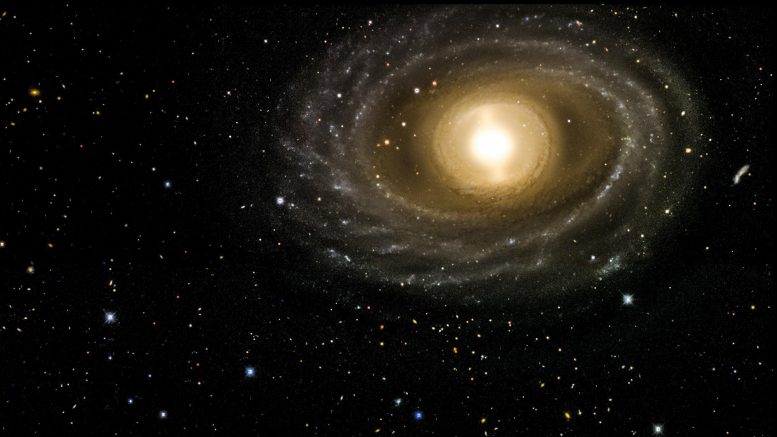
This image of the NGC 1398 galaxy, which is located in the Fornax cluster, was taken with the Dark Energy Camera. Credit: Dark Energy Survey, CC BY-SA
Dark energy is one of the greatest mysteries in science today. We know very little about it, other than it is invisible, it fills the whole universe, and it pushes galaxies away from each other. This is making our cosmos expand at an accelerated rate. But what is it? One of the simplest explanations is that it is a “cosmological constant” – a result of the energy of empty space itself – an idea introduced by Albert Einstein.
Many physicists aren’t satisfied with this explanation, though. They want a more fundamental description of its nature. Is it some new type of energy field or exotic fluid? Or is it a sign that Einstein’s equations of gravity are somehow incomplete? What’s more, we don’t really understand the universe’s current rate of expansion.
Now our project – the extended Baryon Oscillation Spectroscopic Survey (eBOSS) – has come up with some answers. Our work has been released as a series of 23 publications, some of which are still being peer reviewed, describing the largest three-dimensional cosmological map ever created.
Currently, the only way we can feel the presence of dark energy is with observations of the distant universe. The farther galaxies are, the younger they appear to us. That’s because the light they emit took millions or even billions of years to reach our telescopes. Thanks to this sort of time-machine, we can measure different distances in space at different cosmic times, helping us work out how quickly the universe is expanding.
Using the Sloan Digital Sky Survey telescope, we measured more than two million galaxies and quasars – extremely bright and distant objects that are powered by black holes – over the last two decades. This new map covers around 11 billion years of cosmic history that was essentially unexplored, teaching us about dark energy like never before.
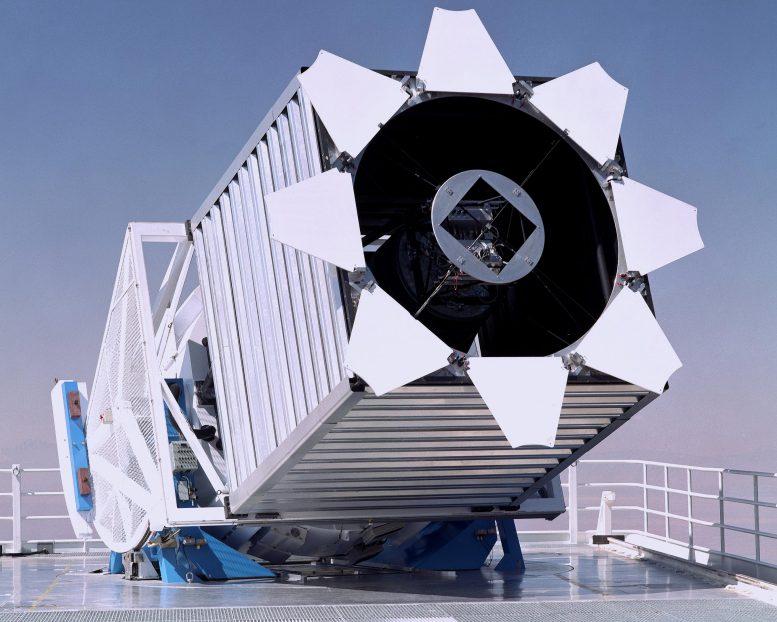
SDSS telescope. Sloan Digital Sky Survey, Credit: CC BY-SA
Our results show that about 69% of our universe’s energy is dark energy. They also demonstrate, once again, that Einstein’s simplest form of dark energy – the cosmological constant – agrees the most with our observations.
When combining the information from our map with other cosmological probes, such as the cosmic microwave background – the light left over from the big bang – they all seem to prefer the cosmological constant over more exotic explanations of dark energy.
Cosmic expansion in dispute
The results also provide a better insight into some recent controversies about the expansion rate of the universe today and about the geometry of space.
Combining our observations with studies of the universe in its infancy reveals cracks in our description of its evolution. In particular, our measurement of the current rate of expansion of the universe is about 10% lower than the value found using direct methods of measuring distances to nearby galaxies. Both these methods claim their result is correct and very precise, so their difference cannot simply be a statistical fluke.
The precision of eBOSS enhances this crisis. There is no broadly accepted explanation for this discrepancy. It may be that someone made a subtle mistake in one of these studies. Or it may be a sign that we need new physics. One exciting possibility is that a previously unknown form of matter from the early universe might have left a trace on our history. This is known as “early dark energy”, thought to be present when the universe was young, which could have modified the cosmic expansion rate.
Recent studies of the cosmic microwave background suggested that the geometry of space may be curved instead of being simply flat – which is consistent with the most accepted theory of the big bang. But our study concluded that space is indeed flat.
Even after these important advances, cosmologists over the world will remain puzzled by the apparent simplicity of dark energy, the flatness of space and the controversial values of the expansion rate today. There is only one way forward in the quest for answers – making larger and more detailed maps of the universe. Several projects are aiming to measure at least ten times more galaxies than we did.
If the maps from eBOSS were the first to explore a previously missing gap of 11 billion years of our history, the new generation of telescopes will make a high-resolution version of the same period of time. It is exciting to think about the fact that future surveys may be able to resolve the remaining mysteries about the universe’s expansion in the next decade or so. But it would be equally exciting if they revealed more surprises.
Written by Julian Bautista, Research Fellow at University of Portsmouth.
Adapted from an article originally published on The Conversation.![]()



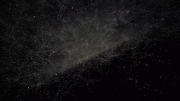
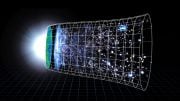
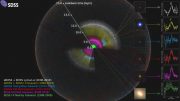
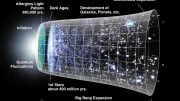

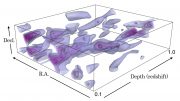
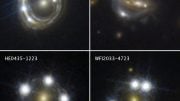
Another way to explain Dark Energy is suggested by String Theory. All matter and energy, including photons (light), have vibrating strings as their basis.
String and anti-string pairs are speculated to be created in the quantum foam, a roiling energy field suggested by quantum mechanics, and they immediately annihilate each other. If light passes near these string/anti-string annihilations, perhaps some of that annihilation energy is absorbed by the string in the light. Then the Fraunhofer lines in that light will move a bit towards the blue and away from the red shift. As this continues in an expanding universe we get the same curve displayed by Perlmutter and colleagues at their Nobel Prize lecture, without the need for Dark Energy.
This speculation has the universe behaving in a much more direct way. Specifics can be found in my YouTube https://www.youtube.com/watch?v=0b6t0jO7IgQ
Picture a stream of fast moving dark energy headed for the sun. When the velocity of the stream and the gravity reach a zero G equivalent (think vomit comet) the dark matter flashes to dark energy creating nano flares. The flares and the expansion of the dark energy would create bubbles with the interface outlined in ionized plasma.
“ The interactions of these ultra-hot electrons and the vacuum created as the tube implodes leads to the flow of electric current. The flow of electric charges is what creates a magnetic field. In this case, the current flow can amplify a pre-existing magnetic field by two to three orders of magnitude, the researchers found.”
https://www.space.com/megatesla-magnetic-fields-earth.html
The dark energy being out of the sweet spot absorbs heat and reverts to dark matter. This would cause coronal rain and in longer streams of dark energy would cool areas all the way to the surface of the sun before regaining sufficient heat to revert to dark matter.
When dark matter leaves the galactic gravity well it flashes to dark energy giving off heat/ nanoflares. This leaves the outside of tha galactic halo hotter than expected and with more hot electrons/ enhanced magnetic fields.
The existence of vacuum energy explains where the quantum fields ground state energies are. We know that they exist from such effects as the Casimir effect and Lamb shift, so observing it at cosmological scales is exciting. What I like most with the eBOSS 20 year survey is that the BOSS collaboration in their cosmology summary paper shortlist some possible explanations for the low vacuum energy density observed, with Weinberg’s anthropic multiverse as the simplest. That is consistent with the type of inflation field that Planck collaboration saw 2016, which naturally results in an infinite number of local universes.
An interesting explanation for the difference between mostly local measurements of the Hubble rate and mostly integrated ones like eBOSS is that the tension can equally well be explained by a tension in the cosmic background temperature calibration. “In conclusion, the authors showed that the Hubble tension can also be expressed as tension in CMB temperature T0. It could, therefore, be solved when a higher T0 is assumed as prior for estimating H0 from Planck data. However, this explanation seems unlikely, as BAO measurements support the lower T0 value. Nevertheless, the analysis showed that the solution to the Hubble tension might not be a change in the cosmological standard model, but rather a careful examination of the assumptions and priors that influence the measurement of H0.” [“Is the Hubble Tension actually a Temperature Tension?”, Linke, astrobites astro-ph reader’s digest.]
The existence of vacuum energy explains where the quantum fields ground state energies are. We know that they exist from such effects as the Casimir effect and Lamb shift, so observing it at cosmological scales is exciting. What I like most with the eBOSS 20 year survey is that the BOSS collaboration in their cosmology summary paper shortlist some possible explanations for the low vacuum energy density observed, with Weinberg’s anthropic multiverse as the simplest. That is consistent with the type of inflation field that Planck collaboration saw 2016, which naturally results in an infinite number of local universes.
Sorry for the duplicate comment – posting difficulties.
@ Howard Jeffrey Bender: “Another way to explain Dark Energy is suggested by String Theory…. quantum foam … my Youtube”.
That is self promotion.
There is no evidence of a “quantum foam” and string theory has mostly been rejected by LHC, ACME and Fermi-LAT – no natural thermal WIMPs from string theory.
@Priyanka Garai: That links to a pseudoscience site.
It is also self promotion.
@Ed Stauffer: “Picture a stream of fast moving dark energy”. If dark energy is constant density in every volume it cannot “stream”.
I would also point out that it is easy to see in the cosmic background spectra that dark energy, dark matter and normal matter are entirely different phenomena and by comparing with other observations of them at later times that they cannot interconvert.
This tenacious quest for finding the explanation the Einstein cosmological constant (constantly verified experimentally to be a constant) is becoming psychotic. Is there such a pressure concerning Newton constant of gravitational attraction? Or the speed of light? Jumping into the craziesr idéa in the hope to finally find “THE EXPLANATION” and get world recognition does not seam a proper way to proceed. Understanding first Why this is definitely a constant and nothing else seams more productive, and is directly in the line of Einstein first idea (exactly the opposite of Archimedes, Newton and Maxwell). There will be plenty of room after for discussion.
“This tenacious quest for finding the explanation the Einstein cosmological constant (constantly verified experimentally to be a constant) is becoming psychotic. Is there such a pressure concerning Newton constant of gravitational attraction? Or the speed of light?”
The interest from cosmologists is that until recently we didn’t know about vacuum energy – it was discovered 20 years ago – and it is just a few years of constraining it to be constant. It is likely that until the tension between the tendency for low-z (“local”) and high-z (“integrative”) observations of the Hubble rate is resolved there will still be room for debate. And it is understandable as such though likely the explanation is found, same as it seems to be for dark matter (which is an older topic of study).
The interest is rather, as I already commented on, the explanation for the low value of the vacuum energy, which famously is 10^120 times lower than naive expectations. This is analogous to how the homogeneity and isotropy of space is 10^5 times lower than naive expectations and it may be that both apparent finetunings derive from the same source – the inflation field.
From the eBOSS collaboration in their latest cosmology summary paper:
“At the high precision found here, cosmic acceleration remains most consistent with predictions from a cosmological constant. A deviation from consistency with a pure cosmological constant perhaps would have pointed toward specific dark energy and modified gravity models. However, since many of these models have parameter choices that make them indistinguishable from ΛCDM, those models all can be made consistent with our observations. Nevertheless, the observed consistency with flat ΛCDM at the higher precision of this work points increasingly towards a pure cosmological constant solution, for example, as would be produced by a vacuum energy finetuned to have a small value. This fine-tuning represents a theoretical difficulty without any agreed-upon resolution and one that may not be resolvable through fundamental physics considerations alone (Weinberg 1989; Brax & Valageas 2019). This difficulty has been substantially sharpened by the observations presented here.”
[“THE COMPLETED SDSS-IV EXTENDED BARYON OSCILLATION SPECTROSCOPIC SURVEY: COSMOLOGICAL IMPLICATIONS FROM TWO DECADES OF SPECTROSCOPIC SURVEYS AT THE APACHE POINT OBSERVATORY”, eBOSS Collaboration, arxiv 2007.08991]
“It is this “weak anthropic principle” that will be applied here. Its relevance arises from the fact that, in some modern cosmological models, the universe does have parts or eras in which the effective cosmological constant takes a wide variety of values.”
“In models of these types, it is perfectly sensible to apply anthropic considerations to decide which era or part of the universe we could inhabit, and hence which values of the cosmological constant we could observe.
A large cosmological constant would interfere with the appearance of life in different ways, depending on the sign of lambda_eff . For a large positiUe lambda_eff, the universe very early enters an exponentially expanding de Sitter phase, which then lasts forever. The exponential expansion interferes with the formation of gravitational condensations, but once a clump of matter becomes gravitationally bound, its subsequent evolution is unaffected by the cosmological constant. Now, we do not know what weird forms life may take, but it is hard to imagine that it could develop at all without gravitational condensations out of an initially smooth universe. Therefore the anthropic principle makes a rather crisp prediction: lambda_eff must be small enough to allow the formation of sufficiently large gravitational condensations (Weinberg, 1987).
This has been worked out quantitatively, but we can easily understand the main result without detailed calculations. … This result suggests strongly that if it is the anthropic principle that accounts for the smallness of the cosmological constant, then we would expect a vacuum energy density p_V ~ (10—100)p_M_0, because there is no anthropic reason for it to be any smaller.”
[“The cosmological constant problem”, Weinberg, Reviews of Modern Physics, 1989]
From the Planck collaboration in their last cosmology summary paper:
“Combining with BICEP-Keck 2015 data on B-mode polarization we find a 95% upper limit on the tensor-to-scalar ratio r_0.002 < 0.06. Together with our measurement of n_s , these results favour concave over convex inflation potentials, suggesting a hierarchy between the slow-roll parameters measuring the slope and curvature of the potential"
["Planck 2018 results, VI. Cosmological parameters", Planck Collaboration, Astronomy & Astrophysics]
A description why a scalar ("slowroll") inflation field naturally gives a multiverse where anthropic considerations (selection bias for survivability) may apply:
"If we look at how this physically works, we can visualize inflation as a field: a ball that sits at the top of a hill. The hill has to be particularly flat on top, so that the ball can spend a lot of time up there. The ball rolls, inevitably, down towards the valley below, but it has to roll slowly: only when the ball sits atop the flat part of the hill can inflation occur. When the ball rolls down into the valley, inflation comes to an end, giving rise to a Universe filled with particles, antiparticles, and radiation: it starts the hot Big Bang.
Again, so far, so good. We have one Universe, it inflates, inflation ends, we get the hot Big Bang, and everyone’s happy.
Until you remember one important caveat that we’ve ignored thus far: everything that physically exists, including all particles and fields, must be inherently quantum in nature."
"Imagine you’re up atop this hill, and you’re rolling slowly towards the valley. At the same time, your position has a probability of spreading out, and while there’s a finite chance that you’ll wind up closer to the valley than you would have otherwise, there’s also a chance that you’ll wind up further up the hill than you started."
"What we wind up with, therefore, is a spacetime where, at any time, inflation ends in a few regions, and we get a hot Big Bang where it does. Each of those regions will be surrounded by a broader spacetime that continues to inflate, where in each of the inflating regions, a few small patches will see inflation end and a hot Big Bang ensue. These various hot Big Bangs will each give rise to their own observable Universe, just like ours, with a different starting point and different specific initial conditions for each region. They will be separated by more inflating space, and no two Universes will ever collide or interact with one another.
This is where the concepts of eternal inflation, the multiverse, and the existence of many disconnected Universes come from. If you accept that inflation is a stage that occurred in the Universe’s past prior to the hot Big Bang, and that the Universe itself is inherently quantum in nature, the existence of a multiverse is unavoidable."
["One Universe Is Not Enough", Siegel, Medium; Siegel is an astrophysicist who often writes in Forbes.]
“This is analogous to how the homogeneity and isotropy of space is 10^5 times lower than naive expectations” – This is analogous to how the deviations from homogeneity and isotropy of space is 10^5 times lower than naive expectations.
Does dark energy impact the stars within a galaxy?
Direct evidence for an accelerating Universe came from observations of type Ia supernovae that showed that remote supernovae are further away than expected as compared to the nearby local supernovae. The expansion rate (km/s/Mpc) for remote supernovae is lower than the expansion rate for the local supernovae. For instance, remote measurement yields an expansion rate of 46 km/s/Mpc (Blanchard et al. 2003) which is much lower than the local measurement of 72 km/s/Mpc by the Hubble Key Project (Freedman et al.)
Working independently on research as a student made me analyse the data, the paper (peer-reviewed) can be found in the following link,
https://www.researchgate.net/publication/343484700
… it is cold outside of our Universe, and we are bit hotter than outside, could that contribute to a spread of the Universe…
You know like hot and cold mixing together and from hot we go out toward the cold, add some tiny, tiny, tiny force, that accumulates due to large sphere … Some calculations needed…
… could it be the pull from outside of the space time and since it is getting bigger and bigger it will have larger and larger values,
… or could it be a that stuff that comes from “nowhere”…
… okay, let’s think>
The Universe come into existence from nothing, and is spreading into nothing, it is formed by nothing we can see(dark matter), and the spread might be directed by nothing we can measure, observe or experience(dark energy). That is just big nothing.
When you believe in the God there is just one assumption, there is the God and end of issues with assumptions. …
No, I am not saying that you should believe in the God, I am just saying that there is way less assumptions needed in order to have a consistent logical system…